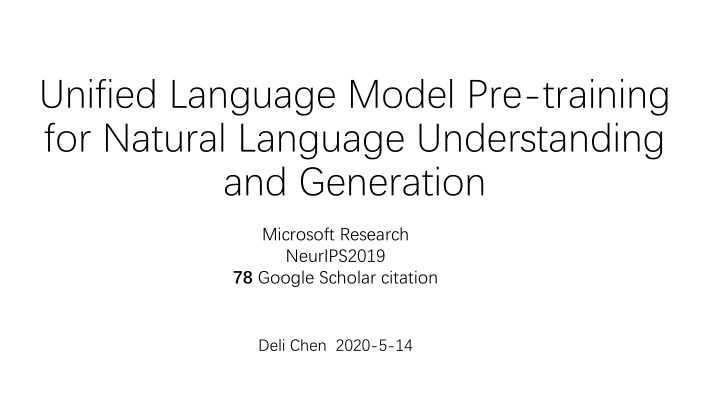
Unified Language Model Pre-training for Natural Language Understanding and Generation Overview
Explore the Unified Language Model (UNILM) designed for both text understanding and generation tasks. Discover its unique features such as three types of masks, shared Transformer network, and impressive performance on various benchmarks. Dive into the pre-training objectives, advantages, and backbone network of UNILM for a comprehensive understanding of this advanced language model.
Download Presentation

Please find below an Image/Link to download the presentation.
The content on the website is provided AS IS for your information and personal use only. It may not be sold, licensed, or shared on other websites without obtaining consent from the author. If you encounter any issues during the download, it is possible that the publisher has removed the file from their server.
You are allowed to download the files provided on this website for personal or commercial use, subject to the condition that they are used lawfully. All files are the property of their respective owners.
The content on the website is provided AS IS for your information and personal use only. It may not be sold, licensed, or shared on other websites without obtaining consent from the author.
E N D
Presentation Transcript
Unified Language Model Pre-training for Natural Language Understanding and Generation Microsoft Research NeurIPS2019 78 Google Scholar citation Deli Chen 2020-5-14
UNILM: Key Words Pre-trained model for both text Understanding and Generation Three types of masks: unidirectional, bidirectional, and sequence- to-sequence prediction Employing a shared Transformer network and utilizing specific self-attention masks Nice performance on both understanding and generation GLUE, SQuAD 2.0, CoQA answering CNN/Daily Mail, Gigaword, CoQA generation
Outline Motivation Method Experiment
Language Model used in different work Understanding BERT, XLNET, ALBERT Generation GPT GPT2
Advantages A single Transformer LM that uses the shared parameters and architecture for different types of LMs; Parameter sharing makes the learned text representations more general because they are jointly optimized for different language modeling objectives The seq2seq mask make the model a natural choice for NLG
Backbone Network: Multi-Layer Transformer We use different mask matrices M to control what context a token can attend to when computing its contextualized representation, as illustrated in Figure 1. Take bidirectional LM as an example. The elements of the mask matrix are all 0s, indicating that all the tokens have access to each other.
Pre-training Objectives Unidirectional LM left-to-right and right-to-left LM objectives are used x1x2 [MASK] x4 , only tokens x1, x2 and itself can be used Bidirectional LM allows all tokens to attend to each other in prediction encodes contextual information from both directions Sequence-to-Sequence LM tokens in the first (source) segment can attend to each other from both directions within the segment tokens of the second (target) segment can only attend to the leftward context in the target segment and itself
Pre-training Setup1 randomly mask word with [MASK], then the model try to recover the masked token the pair of source and target texts are packed as a contiguous input text sequence in training within one training batch, 1/3 of the time we use the bidirectional LM objective, 1/3 of the time we employ the sequence-to- sequence LM objective, and both left-to-right and right-to-left LM objectives are sampled with rate of 1/6
Pre-training Setup2 UNILM is initialized by BERTLARGE, and then pre-trained using English Wikipedia2 and BookCorpus The vocabulary size is 28, 996. The maximum length of input sequence is 512. The token masking probability is 15%. 80% of the time we replace the token with [MASK], 10% of the time with a random token, and keeping the original token for the rest It takes about 7 hours for 10, 000 steps using 8 Nvidia Telsa V100 32GB GPU cards with mixed precision training
Fine-tune Setup NLU task we fine-tune UNILM as a bidirectional Transformer encoder we use the encoding vector of [SOS] as the representation of input, denoted as hL1 , and feed it to a randomly initialized softmax classifier we maximize the likelihood of the labeled training data by updating the parameters of the pre-trained LM and the added softmax classifier NLG task [SOS] S1 [EOS] S2 [EOS] model is fine-tuned by masking some percentage of tokens in the target sequence at random, and learning to recover the masked words
